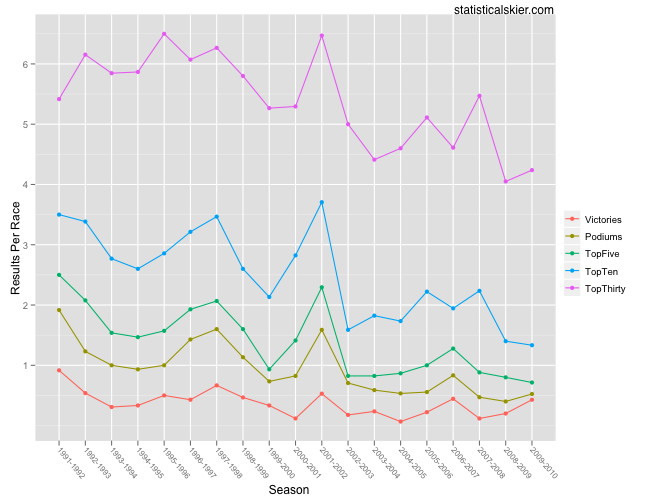There’s been some commentary over the last several years remarking that the Norwegian men, usually quite dominant, have been struggling to crush their competitors into tiny little pieces. Â From the perspective of US skiing fans that might seem absurd, but for better or for worse, Norway has exceedingly high expectations.
It occurred to me, though, that I haven’t actually seen anyone look at some hard data on whether the Norwegian men are actually doing worse these days in distance events. Â To do this, I’m going to drop the more “academic” measure of performance (FIS points) and focus in on finishing rank (1st, 2nd, 3rd, etc).
My rationale here is that Norway is so good at skiing and has so many skiers near the top of the results list that any changes we see in FIS points are going to be very, very small. Â From their perspective, measuring themselves using “percent back from the fastest skiers in the world” is silly, because, come on! Â They are the fastest the skiers in the world!
So what I’ve done is to chart the number of results at a particular level (victory, podium, top five, etc.) per race for each season:
The y-axis here is “results per race”, meaning in the 1991-1992 season, the Norwegian men had around 3.5 top ten finishes per race (first dot in the blue line).
Aside from an unusually good season for the Norwegian men in 2001-2002[1. Not so much in the Olympics, maybe, but across the season as a whole.] you can see a general decline here. Â This decline seems less noticeable with the Victories category, but that may be an issue of scale (all the numbers are smaller, harder to pick out differences). Â I supposed I could replot this and scale everything, but I think this gets the point across just fine.
So the Norwegian men seem to have been getting fewer top results in distance races over the years. Â But again, a lowly American like myself might object that while Norway may be seeing fewer top results in an absolute sense, they may still be doing better than everyone else.
To check this, I went back and calculated the equivalent values from the graph above for the men from (most) every other nation. Â How do Norway’s numbers compare to everyone else’s?
[table id=65 /]
I think it’s fair to say that Norway has seen a decline in a relative sense as well. Â They are still the dominant force in terms of number of skiers finishing in the top thirty, but things have slipped somewhat elsewhere.
If I asked you to split this table into two halves, where would you do it? Â The Norwegian men were top dogs across the board until 2002-2003. Â I think that particular year isn’t terribly special, but they did have a series of retirements leading up to that season. Â There was Bjoern Daehlie, of course, quitting due to injury after the 1998-1999 season. Â Thomas Alsgaard stopped raced in 2002-2003[2. Technically, he did one World Cup race in 2004, I believe.], but his last good season was the year before, 2001-2002. Â Erling Jevne’s last season was 2001-2002. Â Espen Bjervig’s last season was 2002-2003.
Of course, while Norwegians aren’t likely to embrace these kinds of distinctions, there is a difference between “Norway is getting slower” and “Other people are getting faster”. Â And some of that is probably happening. Â Also, we could be seeing the effects of a slightly lengthened World Cup season, which helps to spread the victories around more. Â Finally, it would really help to have data from the 70’s and 80’s, which would provide a richer context for these trends. Â I’d be very curious just how unusual the Norwegian men’s dominance in the 90’s really was. Â It could be that the Norwegian men simply had an extraordinary collection of skiers in the mid to late 90’s.
In any case, should Norway be panicking? Â I think the obvious answer is no, but panicking at the prospect of dropping from best in the world to third best in the world is probably partly why they’re so good in the first place.
[ad#AdSenseBanner]

Post a Comment